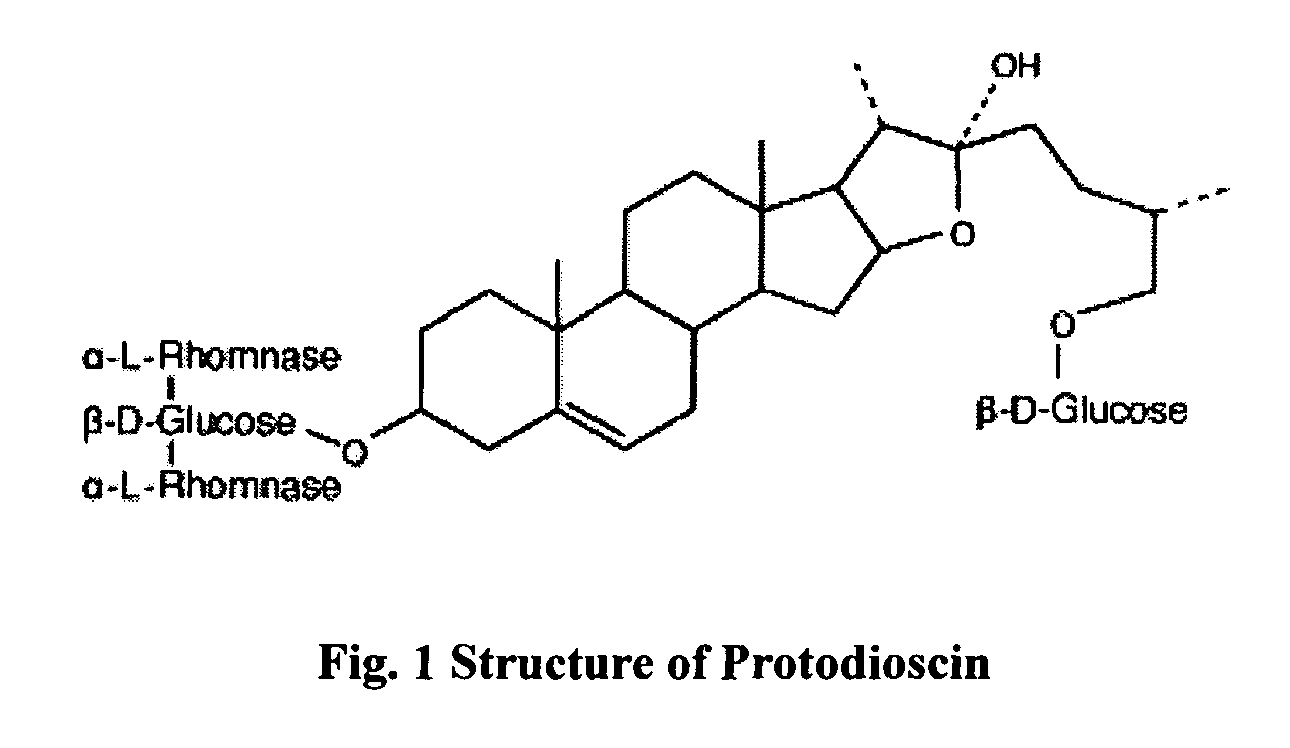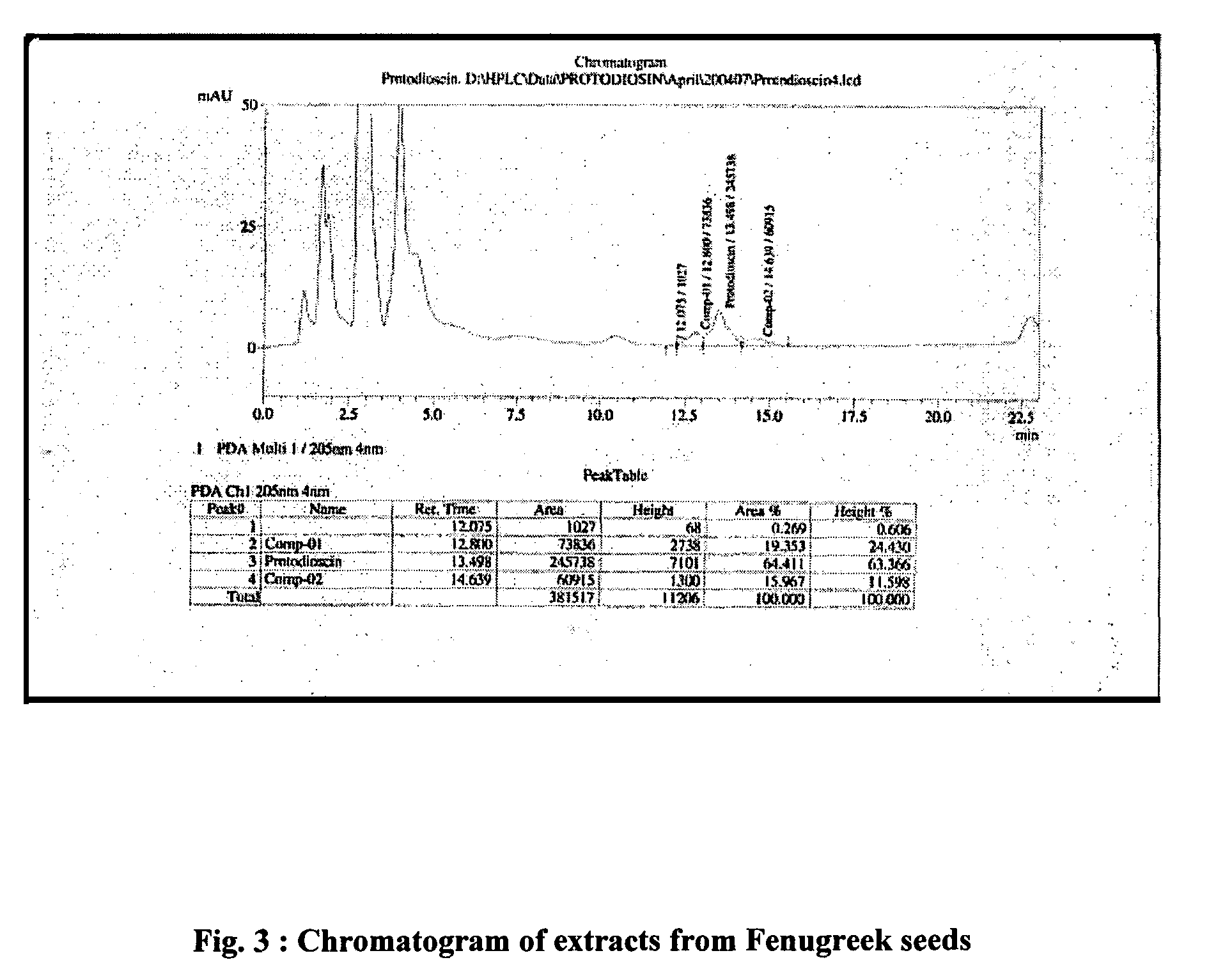Saponins, when injected into the
blood stream, are furthermore highly toxic due to their haemolytic properties.
Cost: At present however, a major obstacle in exploiting the wide range of potential applications of saponins is the fact that commercially available saponins are relatively expensive.
Limited
raw material sources: A problem in this field is that the available sources of
saponin extracts are relatively few.
And in some cases, e.g. Quillaia
bark, the plants are often sparse and expensive because they cannot be cultivated in an efficient manner.
The commercially available
saponin extracts are thus often expensive and / or sparse.
Complex structures, which limit
chemical synthesis: It should also be noted that saponins are quite complicated compounds and it has not so far been profitable to develop methods for
chemical synthesis of these compounds.
However, in order to obtain a highly pure
saponin fraction in the above-described processes, the final purifying step by means of gel
filtration or partition
chromatography was required and led to a low yield of saponins to about 1 to 2%.
This was problematic from the
viewpoints of facility costs and production efficiency for industrially putting such a process into practice.
However, even when such extraction was carried out, material containing saponins which satisfied requirements of high purity and high yield without complicated operation, could not be obtained.
However, it was found that though yield of saponins could be improved under high temperature conditions, but at the same time
solid materials other than saponins also got extracted, which conversely caused a decrease in purity of saponins.
For purification, two complicated stages further were required, which though resulting in pure saponin fractions, resulted in poor yields.
Therefore, it is difficult to separate them by utilizing these properties.
However, malonyl isoflavone
glycoside is unstable to heat and is easily converted into isoflavone
glycoside, acetyl isoflavone
glycoside, or isoflavone
aglycone by heating, which is typically employed in conventional processes.
Once these compounds were generated as a result of heating, it became very difficult to separate these from saponins.
Thus, the above
patent application does not disclose a specific extraction process for the saponins of bioactive interest but only refers to existing conventional methods in general.
It discloses only the removal of saponins as a step for purification of the compounds of interest and does not disclose any specific process for purification of saponins at all.
However, there is no disclosure at all about the extraction process for the saponins of interest.
None of the processes of the prior art reveals a process for the extraction of high-purity (>70%), bioactive furostanolic saponins fractions, particularly
protodioscin, from fenugreek seeds.
However, it does not disclose any process or method for extraction and purification of fursotanolic saponins as in the present invention.
Thus, the disclosure in the prior art is restricted to extraction of
amino acid rich fractions only from fenugreek seeds.
Various natural preparations of FUROSTANOLIC SAPONINS based on extracts of these are available commercially, but suffer from the limitation of variation in therapeutic
efficacy or desirable results.
This results in variation of results, which affects the commercial value and sale of the products.
Theoretically, it is possible to keep on enriching the fractions to obtain
high concentration of bioactive compounds, but this may end up making the process commercially unviable, resulting in non-availability of commercial preparations or the availability of preparations at affordable prices, but with low content of bioactive compounds i.e. FUROSTANOLIC SAPONINS.
However, as per studies available, it was found that the concentration of the pharmacologically
active components i.e. FUROSTANOLIC SAPONINS was much less than the desirable limits.
Taking such a large number of capsules, on daily basis is not practically possible.
It has been reported (Derek Cornelius, 2008 www.qfac.com / articles / syntrax /
tribulus.
html) that none of the commercially available
Tribulus preparations are standardized for furostanolic saponins.
The problem is that
Tribulus contains a fairly large proportion of spirostanolic saponins.
An even further problem is that many products actually contained 40% saponins but had less than 5% furostanolic saponins.
It was found by the inventors that the natural concentration of FUROSTANOLIC SAPONINS in
Tribulus was too less and could not result in a commercially viable process.
Dioscorea deltoidea suffers from the limitation that that its
rhizome portion is used, which is not as abundantly available as are fenugreek seeds and is an
endangered species in some countries.
Practical procedures for large scale quantitative and qualitative
recovery of highly purified FUROSTANOLIC SAPONINS are lacking.
The lack of suitable practical extraction and
purification methods is also reflected in the relatively high cost of those extracts that are available.
 Login to View More
Login to View More 


